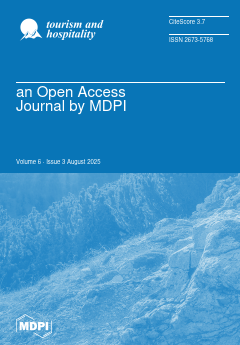Aim: This study extends existing research by focusing specifically on the perceptions of hotel employees, a crucial yet often overlooked group of stakeholders in the adoption of new technologies within the hotel sector. The objective of this research is to investigate the perceptions
[...] Read more.
Aim: This study extends existing research by focusing specifically on the perceptions of hotel employees, a crucial yet often overlooked group of stakeholders in the adoption of new technologies within the hotel sector. The objective of this research is to investigate the perceptions of hotel employees in Hong Kong regarding the implementation of Metaverse hotels. This study emphasizes their evaluations of the strengths, weaknesses, opportunities, and threats associated with these establishments through a SWOT analysis. Ultimately, the study aims to provide recommendations for addressing technological challenges, supporting employees during the transition, and facilitating adaptation across the industry. Design/Methodology/Approach: A convenience and purposive sampling method is employed to investigate 20 participants, comprising hotel staff from various departments in the Metaverse hotel in Hong Kong. This study adopts a qualitative research design, utilizing semi-structured interviews to gather in-depth insights into the perceptions of the Metaverse hotel among these employees. Purposive sampling ensures that participants have relevant experience and familiarity with VR/AR technologies. Interviews, each lasting 45–60 min, were conducted in person, with informed consent obtained beforehand. Findings: The exploration of hotel employees’ perceptions of Metaverse hotels in Hong Kong underscores the innovative potential of these establishments to enhance operational efficiency and guest engagement, while also offering new training opportunities and streamlining daily tasks. However, employees express concerns about the potential erosion of personal interactions, which are crucial to the hospitality experience, and foresee significant technical and integration challenges. Despite these drawbacks, Metaverse hotels present distinctive opportunities for market differentiation, appealing to tech-savvy guests and generating new revenue streams that contribute to industry growth. Nonetheless, potential threats such as guest skepticism and challenges in industry adaptation highlight the necessity for cautious implementation and robust privacy measures. Balancing these aspects—strengths, weaknesses, opportunities, and threats—will be pivotal for the successful integration of Metaverse technologies into the hotel industry. Theoretical/Practical Implications: Participants recognized that the Metaverse hotel could offer various potential benefits for both employees and businesses, such as enhanced operational efficiencies and new opportunities for guest engagement. Understanding the perceptions of hotel staff towards the Metaverse carries significant real-world implications for shaping policies, practices, and technologies that facilitate its operational success and market acceptance. Leveraging these insights enables the optimization of Metaverse’s advantages while mitigating associated risks and drawbacks. This study advances existing research by focusing specifically on the perceptions of hotel employees, a crucial yet often neglected group of stakeholders in the adoption of new technologies within the hospitality sector. By understanding the perspectives of hotel employees, this research provides valuable insights into the practical challenges and benefits of implementing Metaverse technologies in the hotel industry. Originality/Value: The Metaverse hotel is still relatively new and evolving, making it crucial to conduct research to understand how hotel staff perceive it. However, there is limited research specifically focusing on the perceptions of hotel employees regarding Metaverse hotels. This gap highlights the need for a comprehensive investigation into how employees perceive the strengths, weaknesses, opportunities, and threats of implementing the Metaverse in hotels.
Full article




